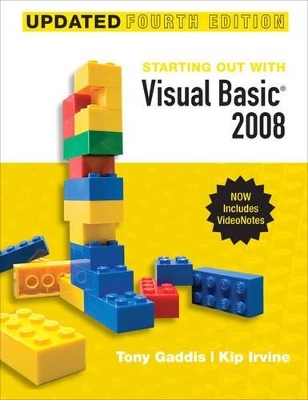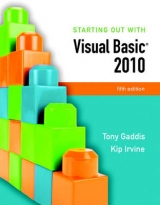
Starting Out With Visual Basic 2008 Update
Pearson
978-0-13-607695-7 (ISBN)
- Titel erscheint in neuer Auflage
- Artikel merken
In the Starting Out with Visual Basic 2008 Update, Tony Gaddis and Kip Irvine take a step-by-step approach, helping students understand the logic behind developing quality programs while introducing the Visual Basic 2008 language.
The 2008 Update edition includes an extensive set of VideoNotes that supplement student reading. Numerous additional problems and an overview of LINQ are also included.
Tony Gaddis is the principal author of the Starting Out with series of textbooks. He has nearly two decades of experience teaching computer science courses, primarily at Haywood Community College. Tony is a highly acclaimed instructor who was previously selected as the North Carolina Community College Teacher of the Year, and has received the Teaching Excellence award from the National Institute for Staff and Organizational Development. The Starting Out with series includes introductory textbooks covering Programming Logic and Design, Alice, C++, Java, Microsoft Visual Basic, and Python.
Chapter 1 Introduction to Programming and Visual Basic
1.1 Computer Systems: Hardware and Software
1.2 Programs and Programming Languages
TUTORIAL 1-1: Running the Wage Calculator application
TUTORIAL 1-2: Running an application that demonstrates event procedures
1.3 More about Controls and Programming
TUTORIAL 1-3: Running an application that demonstrates various controls
1.4 The Programming Process
1.5 Visual Studio and Visual Basic Express (the Visual Basic Environment)
TUTORIAL 1-4: Starting Visual Studio
TUTORIAL 1-5: Opening the Design, Solution Explorer, Dynamic Help, and Properties windows in Visual Studio
TUTORIAL 1-6: Getting familiar with Visual Studio
Chapter 2 Creating Applications with Visual Basic
2.1 Focus on Problem Solving: Building the Directions Application
TUTORIAL 2-1: Beginning the Directions application
TUTORIAL 2-2: Adding a Label control to the Directions application
TUTORIAL 2-3: Setting the Label’s TextAlign property
TUTORIAL 2-4: Changing the Label’s font size and style
TUTORIAL 2-5: Deleting a control
TUTORIAL 2-6: Inserting a PictureBox control
TUTORIAL 2-7: Saving and running the application
TUTORIAL 2-8: Closing a Visual Basic project
TUTORIAL 2-9: Opening an existing project
TUTORIAL 2-10: Using the Object box, Alphabetical button, and Categorized button
2.2 Focus on Problem Solving: Responding to Events
TUTORIAL 2-11: Placing the lblDirections, btnDisplayDirections, and btnExit controls in the Directions application
TUTORIAL 2-12: Writing event procedures for the Directions application
TUTORIAL 2-13: Changing the text colors
TUTORIAL 2-14: Setting the FormBorderStyle property and locking the controls in the Directions application
2.3 Modifying the Text Property with Code
TUTORIAL 2-15: Examining an application that displays messages
2.4 The AutoSize, BorderStyle, and TextAlign Properties
2.5 Clickable Images
TUTORIAL 2-16: Writing Click event procedures for PictureBox controls
2.6 Using Visual Studio Help
TUTORIAL 2-17: Using Dynamic Help in Visual Studio
2.7 Debugging Your Application
TUTORIAL 2-18: Locating a compile error in Design mode
Chapter 3 Variables and Calculations
3.1 Gathering Text Input
TUTORIAL 3-1: Using a TextBox control
TUTORIAL 3-2: Building the Date String application
TUTORIAL 3-3: Using the Focus method
TUTORIAL 3-4: Changing the tab order
TUTORIAL 3-5: Setting access keys, accept, and cancel buttons
3.2 Variables and Data Types
TUTORIAL 3-6: Assigning text to a variable
3.3 Performing Calculations
3.4 Mixing Different Data Types
TUTORIAL 3-7: Examining a Simple Calculator application
3.5 Formatting Numbers and Dates
TUTORIAL 3-8: Examining the Format Demo application
3.6 Exception Handling
TUTORIAL 3-9: Salary Calculation application with exception handling
3.7 Group Boxes and the Load Event Procedure
3.8 Focus on Program Design and Problem Solving: Building the Room Charge Calculator Application
TUTORIAL 3-10: Beginning the Room Charge Calculator application
TUTORIAL 3-11: Changing a label’s colors
3.9 More about Debugging: Locating Logic Errors
TUTORIAL 3-12: Single-stepping through an application’s code at runtime
Chapter 4 Making Decisions and Working with Strings
4.1 The Decision Structure
4.2 The If...Then Statement
TUTORIAL 4-1: Examining an application that uses the If...Then statement
4.3 The If...Then...Else Statement
TUTORIAL 4-2: Completing an application that uses the If...Then...Else statement
4.4 The If...Then...ElseIf Statement
TUTORIAL 4-3: Completing an application that uses the If...Then...ElseIf statement
TUTORIAL 4-4: Comparing an If...Then...ElseIf statement to a series of If...Then statements
4.5 Nested If Statements
TUTORIAL 4-5: Completing an application with a nested If statement
4.6 Logical Operators
4.7 Comparing, Testing, and Working with Strings
TUTORIAL 4-6: Examining an application that performs string comparisons
TUTORIAL 4-7: Completing a string searching application
4.8 Focus on GUI Design: The Message Box
4.9 The Select Case Statement
TUTORIAL 4-8: Examining Crazy Al’s Sales Commission Calculator application
4.10 Introduction to Input Validation
4.11 Focus on GUI Design: Radio Buttons and Check Boxes
TUTORIAL 4-9: Completing an application with radio buttons and check boxes
4.12 Class-Level Variables
4.13 Focus on Program Design and Problem Solving: Building the Health Club Membership Fee Calculator Application
TUTORIAL 4-10: Building the Health Club Membership Fee Calculator application
Chapter 5 Lists, Loops, Validation, and More
5.1 Input Boxes
5.2 List Boxes
TUTORIAL 5-1: Creating list boxes
5.3 Introduction to Loops: The Do While Loop
TUTORIAL 5-2: Completing an application that uses the Do While loop
TUTORIAL 5-3: Modifying the Do While Demo application to use a posttest loop
TUTORIAL 5-4: Using a loop to keep a running total
TUTORIAL 5-5: Examining an application that uses a user-controlled loop
5.4 The Do Until and For...Next Loops
TUTORIAL 5-6: Examining an application that uses the Do Until loop
TUTORIAL 5-7: Examining an application that uses the For...Next loop
TUTORIAL 5-8: Completing an application that uses the For...Next loop
5.5 Nested Loops
5.6 Multicolumn List Boxes, Checked List Boxes, and Combo Boxes
TUTORIAL 5-9: Creating combo boxes
5.7 Input Validation
TUTORIAL 5-10: Completing an application that demonstrates input validation
TUTORIAL 5-11: An example of inconvenient data input correction
TUTORIAL 5-12: Modifying the Validation Demo project to use the SelectAll method
5.8 ToolTips
TUTORIAL 5-13: Adding ToolTips to an application
5.9 Focus on Program Design and Problem Solving: Building the Vehicle Loan Calculator Application
TUTORIAL 5-14: Building the Vehicle Loan Calculator application
Chapter 6 Procedures and Functions
6.1 Procedures
TUTORIAL 6-1: Examining an application with a procedure
TUTORIAL 6-2: Creating a procedure
6.2 Passing Arguments to Procedures
TUTORIAL 6-3: Examining an application that demonstrates passing an argument to a procedure
TUTORIAL 6-4: Working with ByVal and ByRef
6.3 Functions
TUTORIAL 6-5: Examining the GPA Calculator application
6.4 More about Debugging: Stepping Into, Over, and Out of Procedures and Functions
TUTORIAL 6-6: Practicing the Step Into, Step Over, and Step Out commands
6.5 Focus on Program Design and Problem Solving: Building the Bagel and Coffee Price Calculator Application
TUTORIAL 6-7: Building the Bagel House application
Chapter 7 Multiple Forms, Standard Modules, and Menus
7.1 Multiple Forms
TUTORIAL 7-1: Completing an application that displays modal and modeless forms
TUTORIAL 7-2: Completing an application with multiple forms
7.2 Standard Modules
TUTORIAL 7-3: Examining an application that uses a standard module
7.3 Menus
TUTORIAL 7-4: Building a menu
7.4 Focus on Problem Solving: Building the High Adventure Travel Agency Price Quote Application
TUTORIAL 7-5: Building the High Adventure Travel Agency Price Quote application
Chapter 8 Arrays, Timers, and More
8.1 Arrays
TUTORIAL 8-1: Completing an application that uses an array
8.2 More about Array Processing
TUTORIAL 8-2: Examining an application that uses parallel arrays
8.3 Procedures and Functions That Work with Arrays
TUTORIAL 8-3: Examining an application with functions and with arrays
8.4 Multidimensional Arrays
TUTORIAL 8-4: Completing an application that sums the rows of a two-dimensional array
8.5 Focus on GUI Design: The Enabled Property, Timer Control, and Splash Screens
TUTORIAL 8-5: The Timer Demo
TUTORIAL 8-6: Creating a splash screen
8.6 Focus on GUI Design: Anchoring and Docking Controls
8.7 Random Numbers
TUTORIAL 8-7: Examining the CatchMe application
8.8 Focus on Problem Solving: Building the DemetrisLeadership CenterApplication
TUTORIAL 8-8: Building the Demetris Leadership Center Sales Reporting application
Chapter 9 Files, Printing, and Structures
9.1 Using Files
TUTORIAL 9-1: Completing an application that writes data to a file
TUTORIAL 9-2: Completing an application that reads a file
TUTORIAL 9-3: Examining an application that detects the end of a file
9.2 The OpenFileDialog, SaveFileDialog, FontDialog, and ColorDialog Controls
TUTORIAL 9-4: Creating a simple text editor application
9.3 The PrintDocument Control
TUTORIAL 9-5: Adding printing capabilities to the Simple Text Editor application
9.4 Structures
TUTORIAL 9-6: Examining an application with a structure
9.5 Focus on Problem Solving: Modifying the DemetrisLeadership CenterApplication
TUTORIAL 9-7: Modifying the Demetris Leadership Center Sales Reporting application
Chapter 10 Working with Databases
10.1 Database Management Systems
10.2 Database Concepts
10.3 DataGridView Control
TUTORIAL 10-1: Showing a database table in a DataGridView control
TUTORIAL 10-2: Sorting and updating the SalesStaff table
| Erscheint lt. Verlag | 6.3.2009 |
|---|---|
| Sprache | englisch |
| Maße | 213 x 276 mm |
| Gewicht | 1800 g |
| Themenwelt | Mathematik / Informatik ► Informatik ► Programmiersprachen / -werkzeuge |
| ISBN-10 | 0-13-607695-5 / 0136076955 |
| ISBN-13 | 978-0-13-607695-7 / 9780136076957 |
| Zustand | Neuware |
| Informationen gemäß Produktsicherheitsverordnung (GPSR) | |
| Haben Sie eine Frage zum Produkt? |
aus dem Bereich

